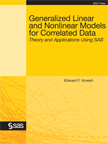Edward Vonesh is a managing member of Vonesh Statistical Consulting, LLC, as well as a part-time employee of Northwestern University, where he supports research in his capacity as professor in the Department of Preventive Medicine. Needless to say, he knows a thing or two about generalized linear and nonlinear models.
We asked him to give us three things that users might not know about these models when it comes to working within SAS. Here you have it, straight from the expert:
- The SAS procedures GENMOD and GLIMMIX allow you to fit marginal generalized linear models (GLIM’s) to correlated data using generalized estimating equations (GEE). Through specification of a “working” covariance structure, GEE allows you to conduct valid non-likelihood based inference about the parameters of the marginal mean assuming only that the marginal mean has been correctly specified. What you may not know is that you can also use the NLMIXED procedure and, in some cases, the GLIMMIX procedure to carry out valid non-likelihood based inference about both the marginal mean and variance-covariance parameters using second-order generalized estimating equations (GEE2). You can accomplish this by fitting a generalized linear or nonlinear model under the “working” assumption that the third- and fourth-order marginal moments are those of a multivariate Gaussian distribution. To do this within NLMIXED, you would specify the distribution of the response to be that of a normal distribution with the desired mean and covariance structure. By specifying a dummy random effect combined with the EMPIRICAL option, the NLMIXED procedure will produce GEE2 estimates of the model parameters together with robust standard errors.
- The SAS procedures MIXED, GLIMMIX and NLMIXED all have options for conducting valid likelihood-based inference for mixed-effects models. To most users it might appear that only the MIXED procedure has the flexibility to fit models in which correlation can be accounted for through specification of both subject-specific random effects (the G-side covariance matrix) and a within-subject covariance structure (the R-side covariance matrix). In contrast, the likelihood-based methods applied to mixed-effects models in GLIMMIX and NLMIXED are limited to mixed models in which correlation is accounted for solely through subject-specific random effects. This restriction would appear to prohibit you from specifying an R-side covariance structure required to model within-subject correlation for nonlinear mixed-effects models. However, you can overcome this limitation in NLMIXED by defining an additional set of “dummy” within-subject random effects that 1) enter the model linearly and 2) are orthogonal to the random effects of your model.
- The mixed-effects models in the MIXED, GLIMMIX and NLMIXED procedures all assume Gaussian-based random effects. Did you know that by using PROC NLMIXED together with assumption that the components of the random effects are independent, you can apply probability integral transformations to fit linear, generalized linear and generalized nonlinear mixed-effects models assuming non-Gaussian random effects? This can be useful, for example, when jointly modeling two different outcome variables using a shared frailty model where the shared random effect is assumed to be from the gamma distribution rather than the normal distribution.
Get more information in Vonesh’s new book, Generalized Linear and Nonlinear Models for Correlated Data: Theory and Applications Using SAS, available for purchase now.
Tags sas